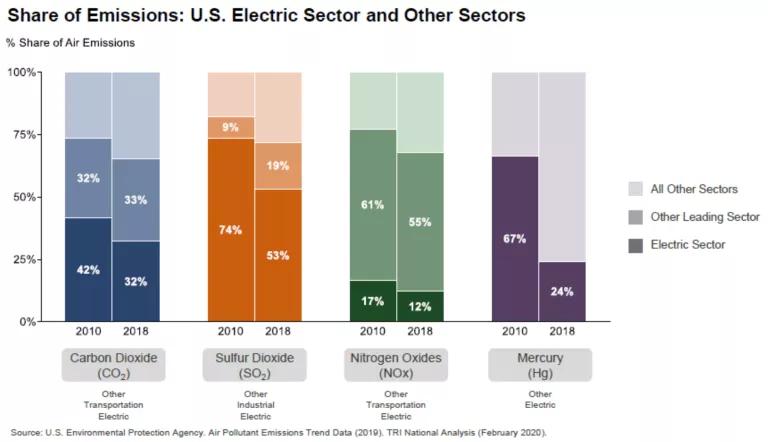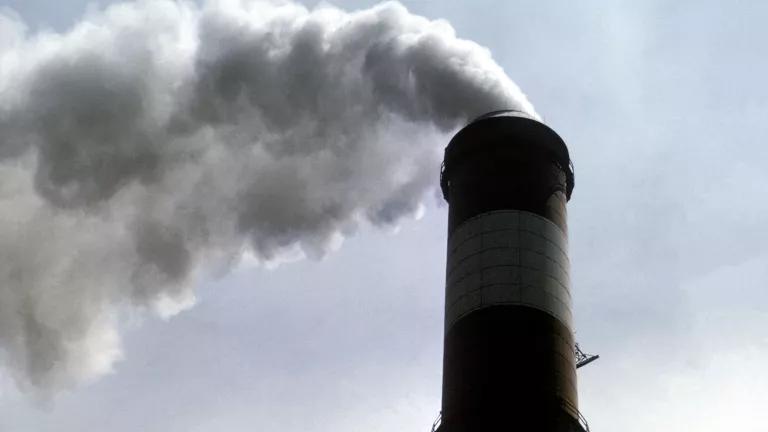2020 Benchmarking: Progress and Opportunity
The trends show that, as the U.S. economy recovers, there are significant opportunities ahead to push for a more prosperous clean energy future that prioritizes emission reductions and investments in the communities that have borne disproportionate pollution burdens.

The largest electricity producers in the U.S. electricity sector succeeded in contemporaneously cutting climate and air pollution while powering a healthy economy in 2019. The new edition of M.J. Bradley and Associates’s Benchmarking Air Emissions of the 100 Largest Electric Power Producers in the United States reports that carbon dioxide emissions declined by 8 percent, sulfur dioxide emissions dropped by 23 percent, and nitrogen-oxide emissions fell by 14 percent as national gross domestic product (GDP) rose by 2.3 percent between 2018-2019. This pattern of growth coupled with emissions reductions continues a long-running trend, though may not hold in the data for next summer’s benchmarking report. The COVID-19 pandemic has disrupted economic activity and is expected to even further accelerate the shift away from coal generation in the electricity sector. These trends show that as the U.S. economy recovers there are significant opportunities ahead to push for a more prosperous clean energy future that prioritizes emission reductions and investments in the communities that have borne disproportionate pollution burdens.
Declining climate and air pollution has been paired with steady economic growth FOR the last two decades
Since 2000, carbon dioxide emissions from the U.S. electricity sector fell 28 percent while GDP steadily grew 45 percent. Going even farther back to 1990, when Congress passed major amendments to the Clean Air Act, 2019 power plant SO2 emissions sank to 94 percent below 1990 levels. Similarly, power plant NOx emissions in 2019 measured 86 percent lower than 1990 levels. CO2 emissions from power plants were 11 percent below 1990 in 2019.
These power sector trends demonstrate a continuation of a longstanding shift away from coal towards lower-emitting, and, in most cases, more economic resources like energy efficiency, clean energy and gas. In 2019, approximately 38 percent of the generation mix was made up of fossil gas, trailed by coal (23 percent), nuclear (19 percent), then wind and solar (9 percent), and hydro (7 percent).

It’s also the third consecutive year in which gas tops the generation mix, and we expect this to stretch into 2020, as the effects of the COVID-19 pandemic further diminish the share of coal. Compared to pre-pandemic estimates from the EIA’s Short-Term Energy Outlook (STEO), coal generation is expected to fall to 17 percent this year. Projections for fossil gas generation have increased to 41 percent from pre-pandemic estimates, as reductions in coal generation exceed the annual demand reduction. EIA’s STEO forecast for renewable energy generation remains unchanged, with a projected record-breaking addition of 23.2 GW of new wind capacity (compared with the current annual record of 13.1 GW of new wind capacity in 2012) and about 12.6 GW of new solar capacity in 2020.

There is still more to do in electricity . . .
A recent report by GridLab and University of California, Berkeley describes a pathway for a 90 percent reduction in emissions from the electricity sector in 2035, primarily driven by growth in wind and solar generation while nuclear generation remains stable. In this scenario, coal generation is eliminated by 2035 and gas generation declines to roughly 10 percent. These changes would require strong policies governing the power plants at all geographic levels as well as policies that address the functioning of electricity markets to ensure accurate valuation of renewable resource performance. A pathway like this one over the next 15 years would position the electricity sector well to meet sector-specific climate targets and support the decarbonization process throughout the rest of the economy as electrification drives greater electricity demand.
The electricity sector has been a leader in reducing climate and air pollution, with companies, cities, and states advancing progress toward a fossil-free future by focusing on energy efficiency and clean energy. These actions could contribute significantly toward keeping the electricity sector as well as U.S. economy on track towards emissions reductions that would be consistent with long-term climate goals. Still, strong state and federal policy actions will be needed to ensure the continued significant emissions reductions necessary each year to prevent the worst impacts of climate change, particularly for the communities that are most vulnerable to climate impacts and are already experiencing climate disruption.
. . . and in other sectors like transportation, buildings and industry
It’s important to remember that the decarbonization pathway that will put the U.S. on a path towards achieving climate goals will require strong action from all corners of the economy. Other high-emitting sectors like transportation and the commercial and residential building stock are beyond the scope of today’s analysis, but still have a crucial role to play in reducing emissions. Even if the electricity sector were to eliminate all of its carbon dioxide emissions today, 68 percent of U.S. emissions would still remain. This is even more stark when it comes to public health. Zeroing out NOx, a pollutant that can cause severe respiratory effects, from the electricity sector would address only 12 percent of the total economy-wide NOx emissions. Making real progress towards our climate and air quality goals will require a concerted effort across all sectors of the economy to reduce all pollution.

We cannot make the progress necessary to get on track without strong and decisive actions from other large-emitting parts of the economy, including vehicles and buildings.
Promising recent developments are pointing in the right direction
There have been a few notable recent developments in non-electricity sectors of the economy that indicate movement towards decarbonization. The California Air Resources Board last week unanimously adopted the world’s first zero-emission commercial truck requirement, the Advanced Clean Trucks rule, requiring that truck makers sell an increasing number of clean, zero-emission trucks in California in place of dirty diesel and gasoline. It is expected to cut toxic fossil fuel emissions in polluted communities throughout California and generate $8.9 billion in health savings between 2020-2040 while creating close to 7,500 jobs by 2040. And in April this year, the model code that establishes the minimum level of energy efficiency in America’s new buildings was strengthened to provide energy savings for consumers and for the environment. We will continue to push for strong and ambitious policies like these to jump start momentum towards deep decarbonization across all parts of the economy.
The downward trend of power sector emissions continues, to the benefit of all, but we need to push that trend further and faster to protect Americans who live in frontline communities and have been bearing the worst effects of climate and air pollution for too long. We know it is possible—our air has been steadily getting cleaner, making it easier to breathe, while our economy has been flourishing. By further expanding renewable energy, improving energy efficiency and supporting innovation, our economy can recover from the COVID-19 pandemic and achieve a cleaner, more prosperous future. We will continue to fight for policies to ensure that the electricity sector continues its progress toward reducing climate pollution and cleaning up the air as it powers our homes and businesses, and that other sectors like transportation and industry quickly follow suit.



